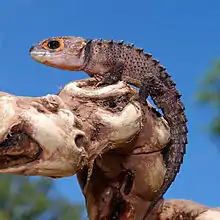Red-eyed crocodile skink
Tribolonotus gracilis, commonly known as red-eyed crocodile skink, is a species of skink that is sometimes kept as an exotic pet. The species is endemic to New Guinea, where it lives in the tropical rainforest. It was first described by Nelly de Rooij in 1909.[1]
| Red-eyed crocodile skink | |
|---|---|
 | |
| Scientific classification | |
| Kingdom: | Animalia |
| Phylum: | Chordata |
| Class: | Reptilia |
| Order: | Squamata |
| Family: | Scincidae |
| Genus: | Tribolonotus |
| Species: | T. gracilis |
| Binomial name | |
| Tribolonotus gracilis | |
Habitat
Tribolonotus gracilis are found in New Guinea island in Indonesia and Papua New Guinea. They live in the humid, tropical forests of the region and have also adapted to live in human-populated areas. While these lizards can climb, they spend most of their time among the leaf litter on the forest floor. When climbing, they will stick to low lying branches and fallen logs. They do not venture to the top of tree canopies.[2]
Behavior
Tribolonotus gracilis is one of the few species of skinks that vocalize[1] when in distress. When startled, they tend to freeze and have been known to "play dead" (even when handled).
Reproduction
The red-eyed crocodile skink's sex can be identified by the white pads, or pores, on their hind feet. Only males have these "pores".[3] Females have only a single working ovary (right ovary), laying one egg at a time. The female often curls around the egg. They show tendencies for mother-child family groups. Male crocodile skinks will battle other males.
Captivity
Red-eyed crocodile skinks are popular in the pet trade but are still considered exotic pets. For captivity they require a large terrarium that can withstand high humidity that the species requires. For nutrient most red-eyed crocodile skinks eat a variety of insects such as fruit flies, mealworms, and small crickets. Like most species of reptiles in captivity, crocodile skinks need a calcium supplement with their regular food.[4]
References
- The Reptile Database. www.reptile-database.org.
- "Red Eyed Croc Skink Care Sheet".
- https://www.herpcenter.com/lizard-care-sheets/red-eyed-crocodile-skink-care-sheet/
- Russell, Matt. "Crocodile Sking Animal Biography" (PDF). Animal Biography. Retrieved 26 January 2017.
Further reading
- de Rooij N. 1909. "Reptilien. (Eidechsen, Schildkröten und Krokodile)." Nova Guinea 5 (3): 375-383. ("Tribolonotus gracilis, n. sp.", pp. 381–382).
- "Red Eyed Crocodile Skink (Tribolonotus gracilis) Care Sheet | Reptile Blog". www.kjreptilesupplies.co.uk. Retrieved 2017-01-26.
External links
| Wikispecies has information related to Tribolonotus gracilis. |
